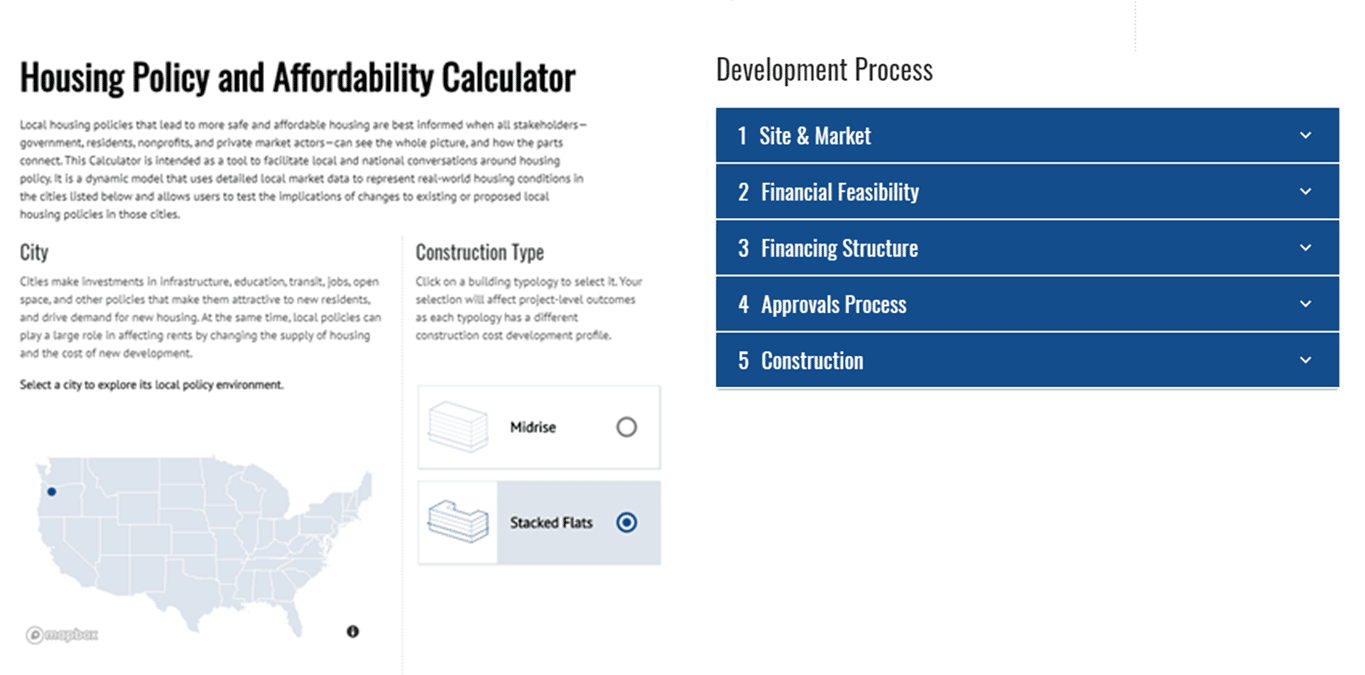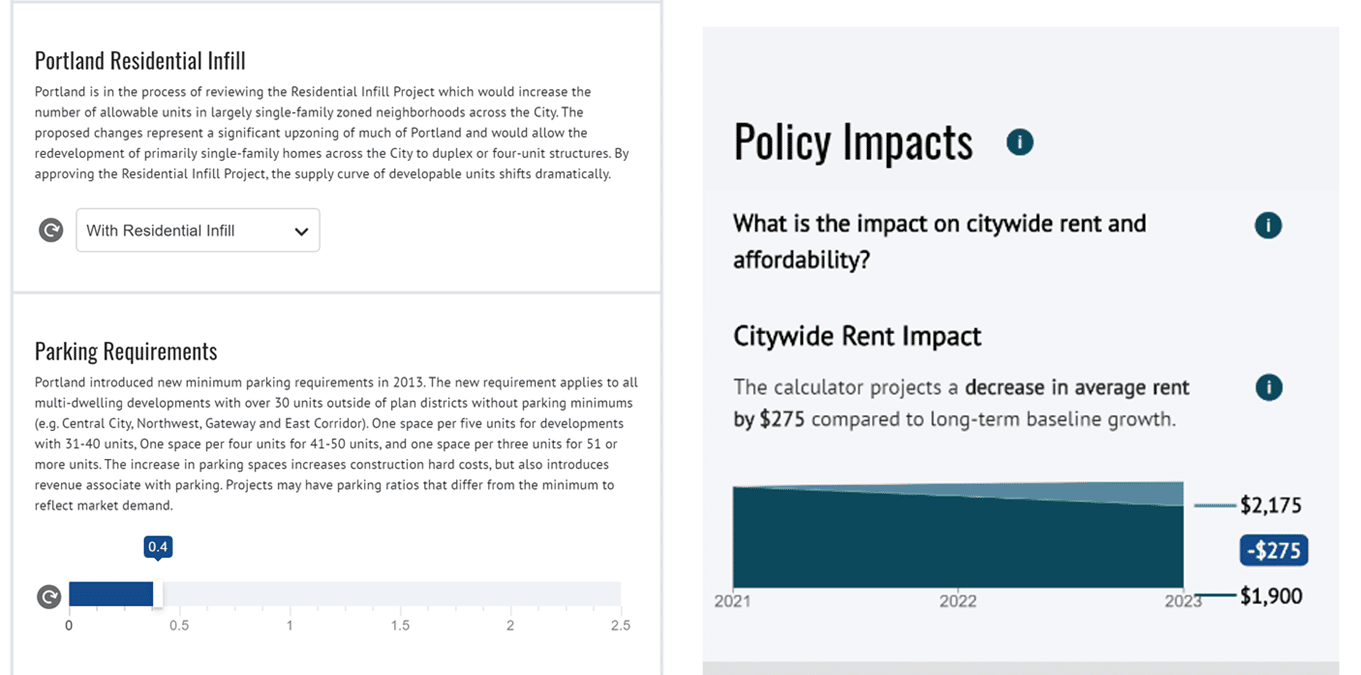Reading time: 7 minutes
The Portland HPAC was developed collaboratively with on-the-ground stakeholders, including the City of Portland and ULI Northwest, and is intended to facilitate local and national conversations around housing policy. Each HPAC is unique and based on policies specific to the city examined. The Portland HPAC can be accessed on Up for Growth’s website.
“As a fast-growing city with significant housing affordability and availability challenges, Portland is the ideal community for our latest Housing Policy and Affordability Calculator,” said Mike Kingsella, Executive Director of Up for Growth. “Portland is currently undergoing a significant examination of its housing policies, including the proposed Residential Infill Project. We hope the HPAC is a tool that policymakers and engaged citizens alike can use to understand the impacts of local housing policy on how much Portlanders pay in rent – and how easily they can find a place to call home.”
The HPAC captures the various policies that most affect the cost to build housing in Portland, based on feedback stakeholder feedback. Categories examined include:
- Site and Market – Portland’s Residential Infill Project and Parking Requirements
- Financial Feasibility – Community Design Standards, Gross Receipts Tax, Annual Property Tax Increase, Green Roof Requirements, Bird Glass Requirements, System Development Charges, and Inclusionary Zoning (both percent of affordable units and level of affordability)
- Financing Structure – Tax Abatement
- Approvals Process – Historic Design Review, Permit Approval Timeline, Appeal Process, Contact Requirements, Design Review
- Construction – Building Permit Fee


“The Up For Growth Housing Policy and Affordability Calculator is a welcome tool which will allow stakeholders throughout the community to come together and speak a common language as we discuss and develop effective, inclusive housing policy in an increasingly challenging market and socioeconomic landscape,” said Doug Burges, Director of Development for Greystar.
The Portland HPAC allows users to examine how policies affect rents and availability for stacked flats and midrise buildings. It does not endorse any specific proposal, but rather allows users to better understand the interplay of policy choices with rents and housing availability. The tool is the product of extensive feedback and meetings with individual stakeholders across Portland, and five meetings over the course of six months. The Local Advisory Committee for the HPAC included representatives from: Business for a Better Portland, GBD Architects, Greystar Real Estate, Hacienda Community Development Corporation, the National Association of Minority Contractors Oregon, Oregon Smart Growth, the Portland Housing Bureau, Prosper Portland, Radler White Parks & Alexander, Sightline Institute, and Urban Asset Advisors.
In conjunction with the unveiling of the Portland HPAC, Up for Growth released a Policy Brief delving deeper into the City of Portland’s Residential Infill Project. The Project’s zoning reform aids in the productions of missing middle housing in areas that are currently zoned only for single detached homes. The Residential Infill Project allows for duplexes, triplexes, quadplexes, cottage homes, townhouses, and accessory dwelling units (ADUs). It is expected to be voted on by the City Council in the coming weeks.
The Brief concludes: “The Residential Infill Project makes huge strides in undoing historic patterns of segregation and exclusion. Its implementation will likely lead to a natural correction, particularly for affordability and access to strong communities. Eliminating zoning and land use barriers opens the market to correctly meet the demand for housing.”
The Calculator was unveiled through a Zoom meeting hosted by ULI Northwest, where Kingsella presented on a panel moderated by Christopher Ptomey, the Executive Director of ULI’s Terwilliger. Other panelists included Samuel Diaz, Senior Policy Advisory in the City of Portland Mayor’s Office; Marty Kooistra, Executive Director of the Housing Consortium of Seattle King County; Ady Leverette, Civic Engagement Director for Business for a Better Portland; and Doug Burges, Development Director for Greystar. The Portland HPAC was developed in partnership with respected real estate economics consulting firm HR&A Advisors.
“A thriving economy depends on a sufficient supply of housing that is affordable to people at all income levels,” said Ady Leverette, Civic Engagement Director for Business for a Better Portland. “But policy discussions on how the public and private sectors can work together to achieve that outcome are often fraught. The UFG Housing Policy and Affordability Calculator helps bring clarity to complex dynamics in the housing market and will hopefully inform more effective policy.”
The HPAC is one of the key pieces of Up for Growth’s research portfolio. In 2018, Up for Growth released Housing Underproduction in the U.S., which pegged the national housing shortage at 7.3-million homes, as measured from 2000 – 2015. Later in 2018, Up for Growth examined Oregon’s housing shortage, determining that the State fell 155,000 homes short of meeting needs over the same time period. From 2000 – 2016, Oregon averaged only .89 new homes for every new household, well behind the national average of 1.1 new homes per new household. In Multnomah County, only .76 new homes were built for every new household.
“No projection is ever going to be a perfect crystal ball, but as someone who’s been watching work on this calculator progress over the last year, I think it’s a good-faith effort to help Portlanders make informed conclusions about the future,” said Michael Andersen, Portland-based Senior Researcher at Sightline Institute. “There are a million ways we can try to hold down housing costs, but they all have tradeoffs and some matter much more to future costs than others. I think the most valuable thing this offers Portlanders is a sense of which policy choices today are likely to be worth it.”
